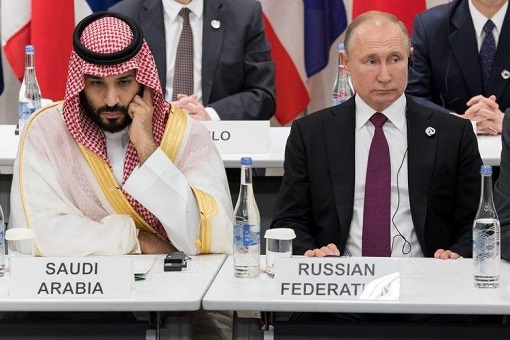Be prepared for US$20 oil in 2020. Ali Khedery, a former ExxonMobil’s senior advisor for the Middle East, said so and now even Goldman Sachs warned that twenty bucks for a barrel of crude oil is absolutely possible. On Sunday, oil prices crashed by more than a third or 30% – the worst one day loss since the 1991 Gulf War. And it could be just the beginning.
On Friday (March 6), the OPEC cartel led by Saudi Arabia wanted Russia to agree on the following new plan – extend existing production cuts of 2.1-million barrels a day throughout the entire 2020 as well as to cut additional 1.5-million barrels. Russian Energy Minister Alexander Novak disagreed and declared that beginning April 1 – everyone can pump as much oil as they like.
All hell breaks loose. Oil prices already dropped more than 10% on Friday when the U.S. WTI crude closed at US$41.28 – its biggest one day percentage drop since November 28, 2014. But it was just the beginning. The real bloodbath started after Saudi Crown Prince Mohammed bin Salman ordered the kingdom’s oil industry to go all the way out to grab market share from Russia and the U.S.

The move taken by the Saudi crown prince essentially set off a panic selling in an already nervous global market. As a result, on Sunday, international benchmark Brent crude futures plunged more than 30% to as low as US$31.02 a barrel. US benchmark West Texas Intermediate (WTI), meanwhile, fell to a low of US$30 a barrel.
On Saturday, Saudi announced massive discounts for April, slashing as much as US$6 to US$7 per barrel for Chinese customers. To make matters worse, Saudi also plans to raise its daily crude output by as much as 2-million barrels per day into an already oversupplied global market. The kingdom currently produces 9.7-million barrels, but can ramp up to 12.5-million barrels per day.
Russian President Vladimir Putin had given up playing the silly game of forever continue to support the crude oil price and in the process has only benefited the U.S. shale oil sector. Since 2016, OPEC and non-OPEC partners have been cutting their production to the tune of 2.1-million barrels per day to prop up the oil prices. Yet, the result was not outstanding.

From the beginning, working with OPEC in defending the crude oil prices instead of protecting market share has been a mistake. The U.S. is now the top oil-producing country in the world, happily snatching market share from Saudi and Russia. Total U.S. oil production climbed to a record 13.1 million barrels a day for the week ended February 28.
It’s not an exaggeration to say that American shale producers have been taking a free ride out of OPEC+ production cut for the last 3 years. Hence, Kremlin wanted to crash the crude oil price as that will also crush American oil production, which in turn will restore the Kremlin’s dominance, at least that was the plan. Now, it’s no holds barred from the U.S., Russia and Saudi.
But the last straw that broke the camel’s back was when the Trump administration imposed sanctions on Russian oil giant Rosneft about 3 weeks ago. The U.S. said the Russian company had violated U.S. sanctions for transporting Venezuelan oil, an action which Secretary of State Mike Pompeo said is effectively propping up dictator Maduro.

A U.S. official claimed Rosneft Trading had facilitated shipping 2-million barrels of oil from Venezuela to West Africa in January alone. Rosneft, whose chief executive Igor Sechin was a longtime ally of Vladimir Putin, has also been accused of engaging in deception and ship-to-ship transfers in an effort to hide the identity of the oil from purchasers.
But the Saudi crown prince might have played into the hands of Putin after his impulsive decision to go nuclear with deep discounts. The crude oil crash was probably what the Russian leader wanted in order to punish the American shale producers. Even after the stock price of Chevron is down 20% in 2020, it is still the best performing energy stock in the U.S.
According to Moody’s, the U.S. oil and gas industry has about US$86 billion of debt and 57% of it is due in just the next 2 years. As oil prices fall and credit markets tighten, many American companies won’t be able to refinance their debts. Even though most energy debt isn’t due until 2022, it will become a great risk if they don’t cut costs and output immediately when things go south.

Thanks to the Saudi’s latest action of crashing the global oil price, the U.S. oil players must cut its production by a few million barrels per day or the oil price could easily fall into the US$20+ a barrel, something that would bankrupt truckloads of American shale producers. Still, this game of flushing out the shale players is a long term game, and cannot happen in one or two months.
Even though Saudi has the world’s lowest oil extraction cost, the kingdom must maintain oil prices in the range of US$60 so that its excessive budget can be funded. In short, Saudi Arabia cannot afford oil prices to be at US$30 a barrel for a long period of time, let alone at US$20, as it will create a huge fiscal hole. While Saudi can play a short-term game, Russia is backed by its National Wealth Fund.
At the end of the day, it’s a game of who will blink first. Saudi Arabia’s plan to pump more than 10-million barrels a day next month will definitely depress the oil industry. But the move was largely seen as an attempt to force Russia back to the negotiating table. However, Putin isn’t someone who you can checkmate so easily. Besides, Saudi may surrender if Trump put pressure on the crown prince.

FINANCE TWITTER



No comments:
Post a Comment
Note: Only a member of this blog may post a comment.